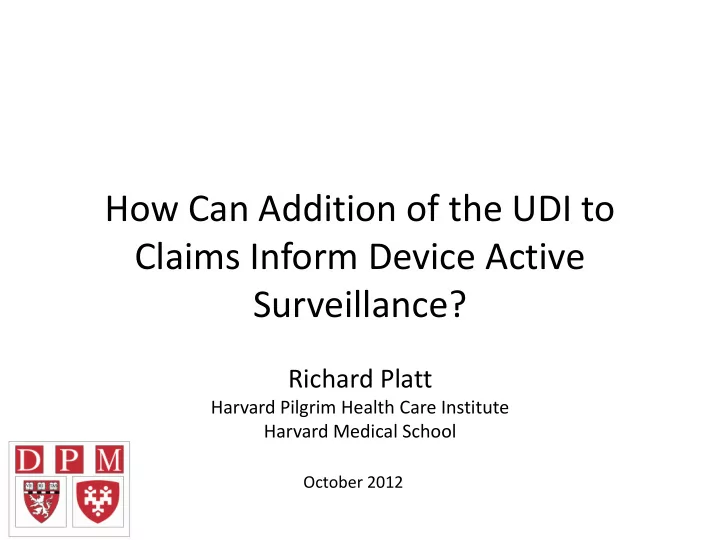

How Can Addition of the UDI to Claims Inform Device Active Surveillance? Richard Platt Harvard Pilgrim Health Care Institute Harvard Medical School October 2012
Does this? Cause this? http://www.sanofipasteur.us/sanofi-pasteur/front/index.jsp?siteCode=AVP_US&lang=EN&codeRubrique=115&codePage=00013 used with permission http://neuro.pathology.pitt.edu/webstuff/NeuromuscularPathology.html
Meningococcal Vaccine & Guillain-Barré Syndrome • Problem: New meningococcal vaccine might increase GBS risk • Methods: – Retrospective study of 12.6 million 11- to 21-y.o. members of five US health plans – Enrollment and claims identified the eligible population, vaccinations, and possible cases of GBS – Cases confirmed by medical record review • Results: – 99 confirmed GBS cases during 18.3 million person-years (5.4/1,000,000 person-years) – 1.4 million meningococcal vaccinations – No confirmed case of GBS within 6 weeks after vaccination – Maximum potential excess risk <1.5 cases per million doses. • Conclusion: No increased risk Velentgas Pharmacoepi Drug Saf. 2012 Jul 16. doi: 10.1002/pds.3321 3
GBS Study Takeaways • Administrative data provided “free” exposure information and preliminary outcome data – Population base was meaningful fraction of U.S. population – Many exposures captured via unique claims code – Outcomes could be confirmed by review of small number of medical records • One-off approach doesn’t scale – Study required years to design and implement – Expensive • New methods/capabilities needed to study many other products 4
Mini-Sentinel Partner Organizations Institute for Health info@mini-sentinel.org 5
Mini-Sentinel Distributed Database 126 million individuals* • 345 million person-years of observation time • Most medically-attended events are known • 13 million people have laboratory test results 2.4 billion encounters • 40 million hospitalizations 3 billion dispensings *As of 12 December 2011. The potential for double-counting exists if individuals moved between data partner health plans. info@mini-sentinel.org 6
Data types under development • State birth registries • Electronic Health Records info@mini-sentinel.org 7
Full text records 90% are available Uses • Confirm critical exposures / outcomes • Obtain historical / clinical detail not in electronic data info@mini-sentinel.org 8
Kinds of active surveillance Older products • Standard • Custom New products • Prospective sequential info@mini-sentinel.org 9
ARBs and celiac disease Potential signal identified in spontaneous reports Review of cases inconclusive info@mini-sentinel.org 10
ARBs and celiac disease 0.080 0.070 Cases per 100 person years 0.060 0.050 0.040 0.030 0.020 0.010 0.000 LOSARTAN IRBESARTAN OLMESARTAN TELMISARTAN VALSARTAN Cases 63 10 17 5 50 New users 235,630 40,071 81,560 24,596 153,159 ARBs: New users after >365 day washout; Celiac Disease: 1st dx code after >365 day without diagnosis. info@mini-sentinel.org 11
One-Time Protocol-based Assessments Rotavirus Vaccines and Intussusception Influenza Vaccine and Febrile Seizures Influenza Vaccine and Pregnancy Outcomes HPV4 vaccine and Venous thromboembolism ACEIs/ARBs/aliskiren and Angioedema info@mini-sentinel.org 12
Common Data Model – Dispensing Table One record per person per NDC per day info@mini-sentinel.org 13
Total hip replacement procedures http://minisentinel.org/assessments/diagnoses_and_medical_procedures/details.aspx?ID=134 info@mini-sentinel.org 14
How can claims-based systems inform device surveillance NOW? • Complement to existing registries – Linkage can avoid need to collect some outcome data • A “poor man’s” registry – For selected devices when there is no stand alone registry
How COULD claims-based systems with UDIs inform device surveillance? • Obviate need for registries to collect exposure data • Assess a wide range of device use and outcomes topics – Safety, Utilization, Effectiveness, Quality of care, etc. • Multiple types of assessments – Rapid, using pre-planned analyses – Protocol-driven – Prospective • Modest extra cost to add to existing assessment systems
Thank you!
Recommend
More recommend